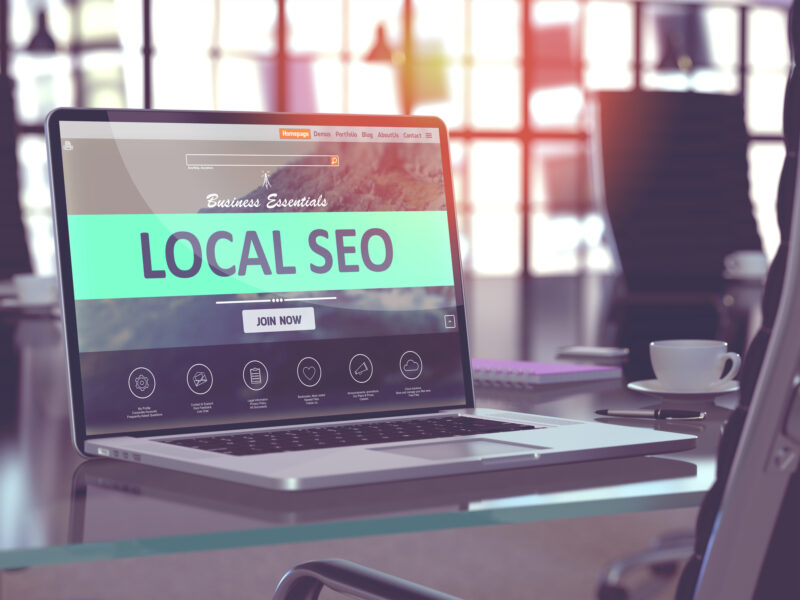Local SEO: What You Should Know for 2021 and Beyond
In 2020, around 93% of consumers went on the internet to find a local business. Around 34% of these use the internet for such a purpose daily.
Why are these numbers relevant? Because they’re big reasons why you should use local SEO.
If you have a physical store or you’re a local business, you need local SEO. You need to target those consumers and make them your customers.
How does local SEO help you with that? Read this guide to local SEO to learn what it is, its benefits, and the best strategies.
What is Local SEO?
Local SEO involves using various methods to help optimize your site for local searches. Wait, what are local searches?
A local search is any query on a search engine that seeks information within a certain geographical area. As such, it usually includes a location modifier or keywords like “nearby.”
In some cases, a local search doesn’t carry such keywords, yet it still has local intent. For example, “hotels in Los Angeles,” “plumber near me,” and “pizza delivery” are all local searches.
In the latter case, Google assumes you’re looking for the nearest place that delivers pizza to you. It won’t show a pizza chain a couple of states away, which won’t be able to reach you anyway. Try using this search phrase in two different locations, and you’ll get different results.
That said, local SEO targets the people using such keywords. You optimize your content, web pages, ads, and so on for the searchers in your area.
You aim for a higher ranking on the local search engine results to target your local audience. To achieve this, use different tactics from general SEO.
SEO vs Local SEO
We can say that local SEO is a sub-category of SEO as its requirements are quite similar. Local SEO is more specific, however. This makes its strategies and practices different from general SEO.
SEO focuses on improving your website’s search engine rankings. Doing so increases its visibility on a national or global scale. Improving your site’s SEO allows you to connect with people in different locations.
Your pages, websites, and ads would be visible to anyone who uses your targeted keywords. If you’re after the amount of web traffic a high-ranking website enjoys, you need general SEO. It has many benefits, like improving your site’s authority.
Local SEO uses many of the same strategies. However, it focuses on connecting with people in your general area.
If your website won’t benefit from traffic outside your area, local SEO is the way to go. A local restaurant, for example, would do better targeting the local population who are more likely to visit than people outside the country.
A local plumbing company would also benefit more from connecting with homeowners whose houses they can reach. If they include people in another state, their strategy would yield them no results.
Why You Should Do Local SEO
Local SEO is more beneficial for local businesses. Some examples of those that can benefit from it are:
- Brick and mortar stores
- Local restaurants
- Doctors
- Lawyers
- Plumbers
These businesses can only service those within their area. Hence, why it doesn’t make sense for them to cast a bigger net. It wastes time, money, and effort.
For instance, doctors would likely only get local patients as people won’t travel to get a check-up. Some brick and mortar stores can be an exemption if they ship to other locations as well.
Here are some other reasons why you should do local SEO:
1. Stay Ahead of Competitors
Even when you’re not doing local SEO, your competitors will. That means they’re gaining more visibility than you.
When a potential customer conducts a local search, your competitor will show up higher on the SERP than you. Worse, your business listing won’t show up at all.
Like we said earlier, even though local SEO is almost similar, it uses different tactics. Your competitor would use Google’s special pack for local searches, for example. It allows them to reach a customer faster than you.
If you want to stay ahead of competitors, start doing local SEO. It allows your audience to find your business and information about you more easily.
Note that you might also be competing with big brands. A local pizzeria would also be competing with large pizza chains like Domino’s, Pizza Hut, and others. These brands operate on a national and global scale.
If you compete on the same playing field, you’ll likely lose. Instead of facing them head-on, use local SEO instead. You get more chances of dominating this way.
2. Have Visibility in Other Platforms
Local SEO doesn’t limit you to Google; it also encourages you to improve your online visibility by creating a presence on local directory websites (more on that later).
If you abide by the local SEO best practices, you’ll have to create listings on Yelp, TripAdvisor, Waze, and so on. These are platforms consumers use to look up information or read reviews. Having a presence here allows you to reach these people.
3. Take Advantage of Smartphone Use
Local SEO is more effective today thanks to the rise in usage of smartphones. By 2016, mobile phones overtook desktop computers in web traffic shares. Today, internet users perform more local searches on their mobile phones than on computers.
This is advantageous for local SEO because smartphones have built-in GPS capabilities. It’s easier for Google to serve what they need when they input a local query on the search engine.
Whenever a user wants to search for a business, they go to Google using their mobile phones. Local SEO allows you to target these people and convert them into your customers.
4. Get More Offline Purchases
Did you know that around 50% of smartphone users who performed a local search visited a store within a day? For desktop users, the number comes to around 34%.
This means you have the potential to get more sales thanks to local SEO. However, how does an online search lead to an offline purchase?
That’s because consumers now tend to search online before buying a product or service. Around 56% of shoppers look up reviews to help with their buying decisions.
They may go online to confirm the existence of a business, for instance. They may also look for the address and other information or read reviews about it. They may also use the internet to search for a local business that fits their current needs.
The more visibility you have, the more likely you’ll get a visit or a call. Even if the searcher is already aware of your business, they might go to a competitor instead if they can’t find you.
5. Find More Customers at a Lower Cost
Casting a smaller net doesn’t mean you’ll get fewer customers. Although local SEO is a smaller net, it has smaller holes, as well. Which do you think catches more fish, this or a bigger net with bigger holes?
Once you know your target audience, you don’t have to go beyond that. Local SEO allows you to target a specific group—the locals.
The locals are people close to you that are actively searching for your business. These are the ones with higher chances of becoming a customer.
As such, you’ll get more customers for less. Although local SEO still requires money and effort, you’ll put your resources into something that would give you a higher return on investment. Instead of paying for an ad that would reach more people, you would pay less for a targeted strategy.
Best Local SEO Practices
Even if you are knowledgeable about SEO, that doesn’t mean you’re ready for local SEO. You have to use different tools and try different avenues to gain more local visibility. Here are some local SEO tips to improve your efforts:
1. Create a Google My Business Account
Google My Business might be the most important element in local SEO. After all, the search engine trusts its products more. If you have a GMB account, Google can verify you and thus, trust your business, as well.
When you sign up for Google My Business, you will provide your website, contact information, address, and more. It’s easier for customers to find your information on Google searches.
Having an account lets you enjoy Google’s 3-pack feature for local businesses. It’s the top three results in the SERP, displaying three local businesses relevant to the user’s search. These coveted spots give more visibility for businesses and relevant information for customers.
A GMB account also lets you set up a pin on Google Maps. This increases your visibility further and makes your business easier to visit.
2. Mind Your NAP
NAP stands for name, address, and phone number. These three usually appear together in a local search.
Make sure your business’s NAP is consistent throughout the internet. They should be the same in your website, directories, GMB, social media, and everywhere else.
Remember that Google likes consistency. It doesn’t like getting confused about which information is correct. Being consistent also allows you to look more credible and trustworthy.
3. Create a Presence Local Directory Sites
Like what we’ve discussed earlier, a part of local SEO is signing up on local directories. Signing up on sites like Yelp not only gives you more visibility but also establishes your presence.
You make it easier for your customers to know more about your business this way. It also gives your customers a platform for submitting reviews. In turn, you get to engage with them further even after they’ve completed a transaction with you.
Having a presence everywhere helps you look more credible as well. Bonus points if you’re active on several platforms, including social media.
4. Build Location Pages
A location page is a dedicated page on your site about a specific branch. It should contain the address, contact details, operating hours, and more. You can even include directions, current promos, and an embedded Google Maps.
If you have multiple branches, make sure each location has a separate page. If you only have one location, make sure you have no duplicates.
Location pages aren’t only for the benefit of the customers. They’re good for SEO too, as they make it easier for Google to understand each location.
A location page is only one of the many pieces of content necessary for local SEO. For more on content creation, click here.
5. Have a Responsive Web Design
As we’ve learned, smartphones have a big impact on local SEO. That’s why you should make sure your website is ready for mobile searches.
A responsive web design ensures that your website is viewable without distortions and awkward elements on any device. It’s because your website adjusts automatically to the size of the screen.
It means you don’t need a separate design for mobile devices, unlike in the years past. You don’t need a mobile subdomain as well.
6. Engage Your Local Community
When targeting locals, you need to engage with them to gain more visibility and authority. As such, you need to make an effort to reach out to them by joining your local community.
One way is to create content about your area, like the top local pizzas, sights to see, and more. You can also collaborate with other local businesses. You can promote each other and access each other’s audiences.
By being a part of your community, you get more brand visibility. It also earns you more local backlinks, which are valuable for Google.
Learn More About Local SEO
Everything you’ve learned about local SEO here is just the tip of the iceberg. Learning SEO is continuous as you need to keep track of the updates to the algorithm and the latest trends.
Don’t worry, we got your back. Visit our website today to learn more.


